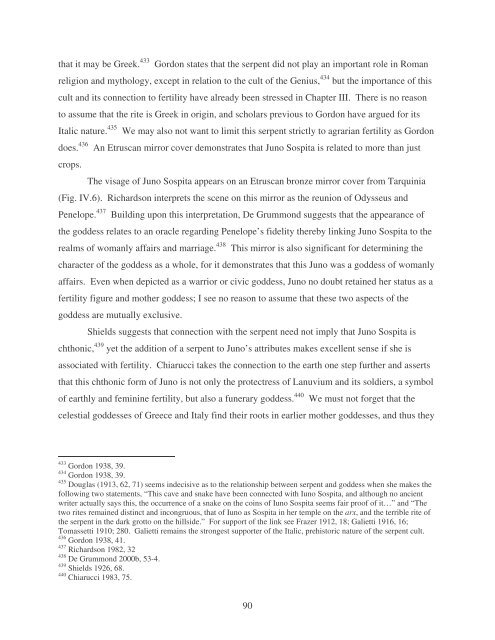Final Draft - Preview Matter - Florida State University
Final Draft - Preview Matter - Florida State University
Final Draft - Preview Matter - Florida State University
Create successful ePaper yourself
Turn your PDF publications into a flip-book with our unique Google optimized e-Paper software.
that it may be Greek. 433 Gordon states that the serpent did not play an important role in Roman<br />
religion and mythology, except in relation to the cult of the Genius, 434 but the importance of this<br />
cult and its connection to fertility have already been stressed in Chapter III. There is no reason<br />
to assume that the rite is Greek in origin, and scholars previous to Gordon have argued for its<br />
Italic nature. 435 We may also not want to limit this serpent strictly to agrarian fertility as Gordon<br />
does. 436 An Etruscan mirror cover demonstrates that Juno Sospita is related to more than just<br />
crops.<br />
The visage of Juno Sospita appears on an Etruscan bronze mirror cover from Tarquinia<br />
(Fig. IV.6). Richardson interprets the scene on this mirror as the reunion of Odysseus and<br />
Penelope. 437 Building upon this interpretation, De Grummond suggests that the appearance of<br />
the goddess relates to an oracle regarding Penelope’s fidelity thereby linking Juno Sospita to the<br />
realms of womanly affairs and marriage. 438 This mirror is also significant for determining the<br />
character of the goddess as a whole, for it demonstrates that this Juno was a goddess of womanly<br />
affairs. Even when depicted as a warrior or civic goddess, Juno no doubt retained her status as a<br />
fertility figure and mother goddess; I see no reason to assume that these two aspects of the<br />
goddess are mutually exclusive.<br />
Shields suggests that connection with the serpent need not imply that Juno Sospita is<br />
chthonic, 439 yet the addition of a serpent to Juno’s attributes makes excellent sense if she is<br />
associated with fertility. Chiarucci takes the connection to the earth one step further and asserts<br />
that this chthonic form of Juno is not only the protectress of Lanuvium and its soldiers, a symbol<br />
of earthly and feminine fertility, but also a funerary goddess. 440 We must not forget that the<br />
celestial goddesses of Greece and Italy find their roots in earlier mother goddesses, and thus they<br />
433 Gordon 1938, 39.<br />
434 Gordon 1938, 39.<br />
435 Douglas (1913, 62, 71) seems indecisive as to the relationship between serpent and goddess when she makes the<br />
following two statements, “This cave and snake have been connected with Iuno Sospita, and although no ancient<br />
writer actually says this, the occurrence of a snake on the coins of Iuno Sospita seems fair proof of it…” and “The<br />
two rites remained distinct and incongruous, that of Iuno as Sospita in her temple on the arx, and the terrible rite of<br />
the serpent in the dark grotto on the hillside.” For support of the link see Frazer 1912, 18; Galietti 1916, 16;<br />
Tomassetti 1910; 280. Galietti remains the strongest supporter of the Italic, prehistoric nature of the serpent cult.<br />
436 Gordon 1938, 41.<br />
437 Richardson 1982, 32<br />
438 De Grummond 2000b, 53-4.<br />
439 Shields 1926, 68.<br />
440 Chiarucci 1983, 75.<br />
90

















